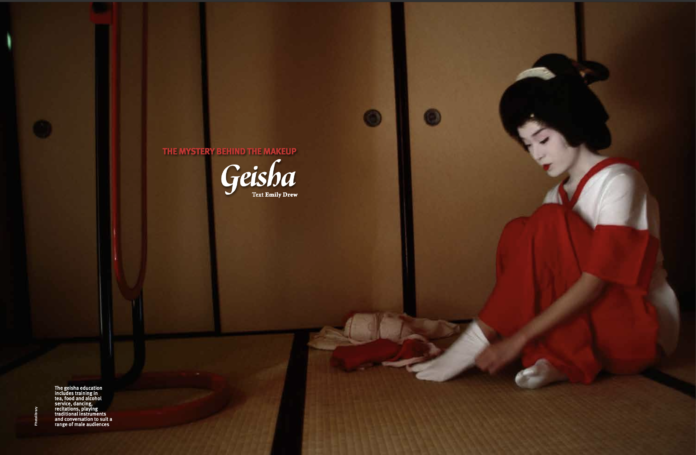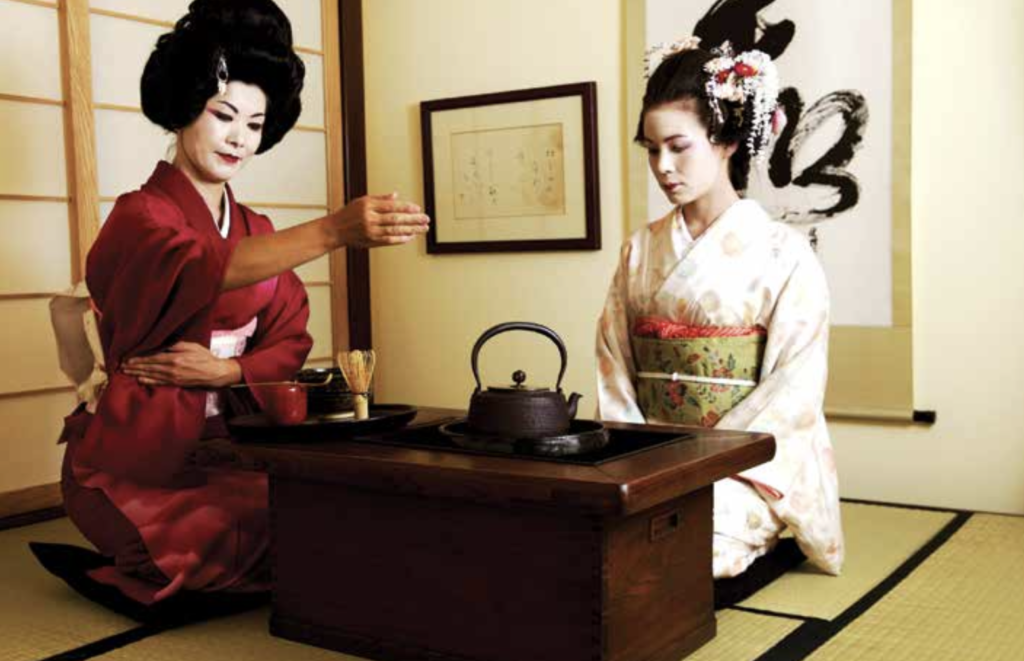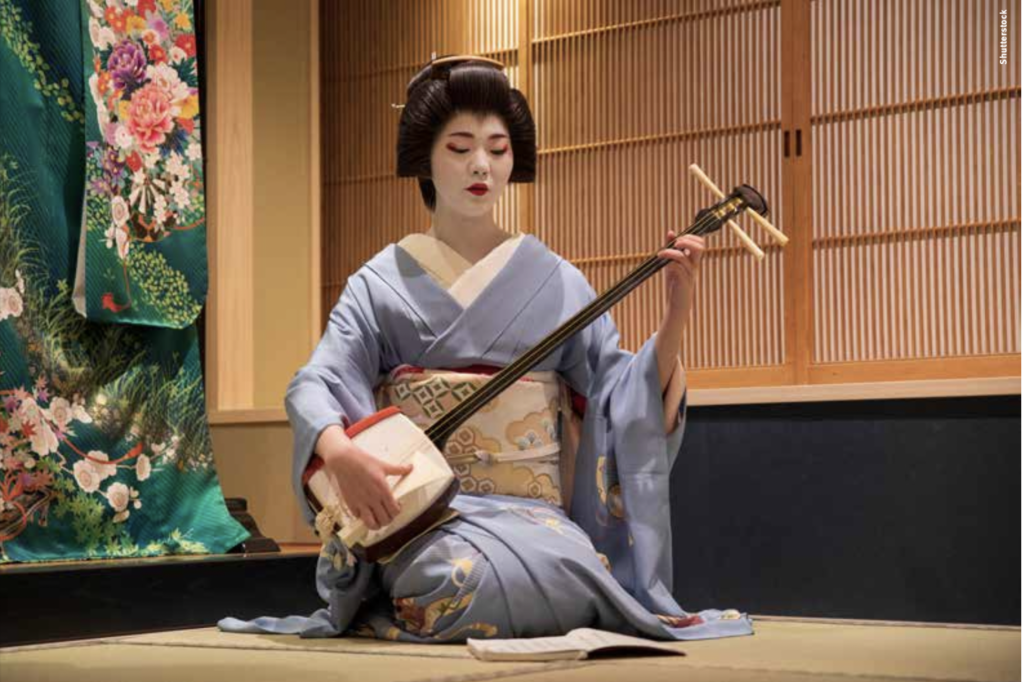
Text: Emily Drew
Our tourist boat sailed down the central river of Tokyo and stopped near Ginza, a high-end district with a walking street paved with the likes of Gucci, Versace, Prada and Louis Vuitton.
A friend and I moved from the dock towards the street with dozens of other tourists. We noticed a woman in elaborate, traditional robes, her hair worn up. She walked with great poise. Her aged and dignified face showed that she had probably been a young woman during the pre-World War II Japanese imperial glory.
We wondered whether she was a geisha, but a Japanese man we had befriended on the boat laughed at us, as my friend whipped out her camera with excitement. “That’s not a geisha,” he said, “It’s only 10 in the morning! The geishas aren’t out yet. She’s just a rich old woman. Go to Kyoto for real geishas.”
Like a few other tourists from our boat, we assumed she was a geisha simply because she wore the traditional Japanese dress and walked gracefully. Geishas are a misunderstood bunch. For one, there are geishas in many parts of Japan, not just in Kyoto, like the man suggested.

The Myths and Making of Geisha
There are several other myths to dispel. Firstly, geishas are not prostitutes; they sell their talent, not their bodies. Secondly, geishas are not mindless dolls; they are highly educated, especially in the arts. Thirdly, geishas are rare, even in Japan, and there are many impostors.
Finally, geishas are not necessarily wealthy. Many are high school or university graduates when they begin, but only the very best can make top salaries exceeding €170,000 (psD186,000). Others are left with perhaps €35 (us 38) per hour to pay for the expenses of makeup union fees, and maintaining a wardrobe of around 60 kimonos, ranging from €1,700 (USD1,860) to €24,000 (USD26,250) each.And there are the classes to pay for.
The word geisha means “artist”, and the purpose of geishas are to bring art and beauty into the world, especially into the lives of their clients. To do this properly, training can last for years. In most places, apprentice geishas are called maiko (dancing child), but training traditions and durations vary from city to city, as do traditional characteristics of geishas; Tokyo geishas are said to be sassy and Kyoto geishas demure. As well, Tokvo trainees usually start their training later in life, some after university, and are called “half-jewel” or “one who pours alcohol”.
Their education – whether six months in Tokyo or, as was once common in Kyoto, from childhood – includes training in tea, food and alcohol service, dancing, recitations, playing traditional instruments like the three stringed shamisen, and conversation to suit a range of male audiences. They are also expected to learn how to handle rowdy clients and reject sexual advances without making men feel awkward or out-of-line.
Appearance and personal maintenance is another skill set that must be perfected before an apprentice can become a full geisha.
Another myth rests on the appearance of a geisha; they do not use white face makeup. That face paint is actually the makeup that marks a maiko, the apprentice. Sometimes, a full geisha will wear it, but for geishas over 30 years old, it is only worn at special performances.
The white paint is made of rice powder and is applied over the face, neck and chest in a way that accentuates the erotic nape of the neck and gives an illusion of a mask at the face’s hairline. maikos also sport bright red lipstick and black and red eye shadow and liner.
Hairstyles have varied throughout history and today, they still vary from region to region and from apprenticeship to full geisha. No matter which style is preferred – and whether or not it is the geisha’s wig or the maiko’s natural locks – the hair is styled by professionals. Wigs are more common now, as the strenuous styling can result in balding.
A geisha’s clothing, like her mane, is cared for and put on by professional assistants. The kimono is the stock attire. As with contemporary garb, a geisha’s attire changes style, colour and pattern with the seasons. Unlike most clothes of today though, a kimono can take several years to complete by hand.
Clothing styles also change depending on how old and experienced the geisha is. More subdued colours and cuts are a sign of maturity, as is more subtle makeup (without the white foundation) and hair styling. Age is not necessarily a bad thing in the world of geisha. The most experienced will tell you that only after 40 can a woman elicit the true nature of a man.

A WALK IN GION, KYOTO
The quest for geishas took us to another Japanese river, the Kamo-gawa in Kyoto. Along its banks is Gion, a famous traditional distriet whose 17th-century wooden teahouses have hosted centuries of geisha entertainment.
The teahouses line the roads of Hanami-koji, Shijo-dori and Shirakawa Minami-dori, among others, and geishas and maikos are frequenters throughout the day. You might catch them in full dress on their way to their clients in the evenings, usually after Spm – they will have spent hours in preparation for their nights out, which usually last until midnight or so. A geisha is always with at least one other woman.
At the Mifune Matsuri (Three Boats Festival), you can see geishas hired by businessmen to accompany them to the event. Held every spring, the festival commemorates imperial Japan with 30 boats of costumed participants floating up the Oi River. Those in the parade perform plays, recite poems, play music and, on the boat of shrine maidens, carry offerings. It is a perfect event for a geisha or maiko to attend – traditional, full of the arts, aesthetically pleasing.
Beside the teahouses, Gion also has its share of contemporary clubs and bars, many of which are exceptionally exclusive, like the ones in Ginza in Tokyo. Geishas also entertain their clients here, but only the lucky few (males) can get into such places.
As a female foreigner, I can’t hire a geisha, but I could (theoretically) become one or, more realistically, I could be temporarily transformed to look like one. The geisha tradition is used for an array of clever business endeavours. In Kyoto, an industry called “geisha transformation” has sprung up, now serving tens of thousands of tourists a year.
More than 40 studios in Kyoto will paint your face, doll your hair and dress you in a real kimono. When the visual transformation is complete, you can opt for a photo shoot or sometimes even a walk around town or in a private garden. Prices range from around 12,000 (USD90) for basics to 50,000 (USD370) for the best of everything, including the privilege of slipping into a designer kimono.
For many, the geisha has become a fetish. Women dream of attaining a geisha’s sensuality and her ability to lure and control men. Men, such as the businessmen at the Three Boat festival, lovethe idea of being entertained by a beautifully decked-out woman, whose one concern is their pleasure – for a fee of course – with no strings attached and no guilt.
For others, though, geishas are the surviving soul of a lost culture.

CENTURIES OF SURVIVAL
The first geisha were men. They had been entertaining since the mid-1600s. About 100 years later, the first female geisha began practising. They replaced a thousand-year-old line of women who, throughout Japan’s history, had learned the arts out of necessity. Singing, dancing and reciting poems and religious texts were ways homeless and poor women set themselves apart from other women, earning their keep. The most skilled – often daughters of disenfranchised aristocracy – could hope for a place in the home of a wealthy patron.
The number of female geishas started to surpass their male counterparts. They became incredibly popular by the mid-1700s. The elegant and entertaining women had some things that the women of the elaborate “pleasure gardens” didn’t have – they were masterful in several arts, they had a reputation for purity and they had an aristocratic air. The pleasure gardens were for sex, the geishas were for refined companionship. Both sets of women lived under control of men who arranged their clients, lifestyle and behaviour – there were strict rules of conduct and rigid hierarchy among the women. During World War II, prostitutes often pretended to be geishas or maiko to attract the business of foreign soldiers, and from there, the West began to think geishas were for sex as well.
Today, that myth is mostly dispelled, and as many businessmen in Kyoto would attest, there is still a place for the geisha. But the culture has been threatened since the end of the war by the changing climate of business and politics in Japan. For example, the ryotei, a type of traditional fine-dining Japanese restaurant, was once the main place to conduct sensitive business and politics. In Tokyo’s ryotei, the country’s most powerful men met to decide the future, with only the geisha for company – these places were renowned for their secrecy and aura of seduction, thanks to their small rooms broken into private compartments, on-site sleeping quarters and geisha hostesses. Now, there are fewer than 100 of these private inns and restaurants in Tokyo, down from more than 400 in the past 30 years. Strict business transparency laws have led to the dwindling need for the ryotei’s atmosphere.
Another threat to the geisha culture is the increased opportunities for women in business and politics. The culture of female entertainment was strongest in Japan when women had fewer ways to earn money. Today, a woman can make far more money in the boardroom than in the teahouse, and many are doing just that.
For more stories from this issue, get a copy of Asian Geographic Passport No.158 or subscribe at https://shop.asiangeo.com
The largest and longest-running Asian Dive Expo ADEX Japan 2024 will be held on 25-27 October 2024 in Tokyo, Japan.










